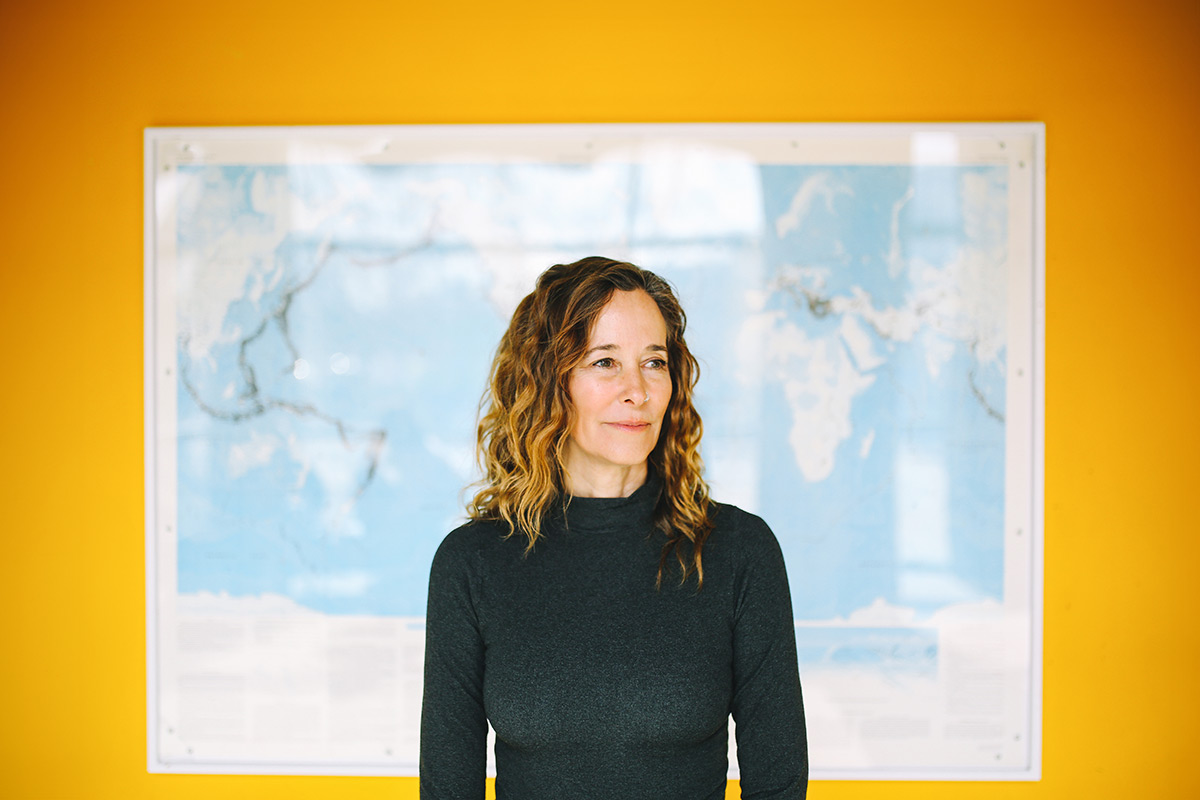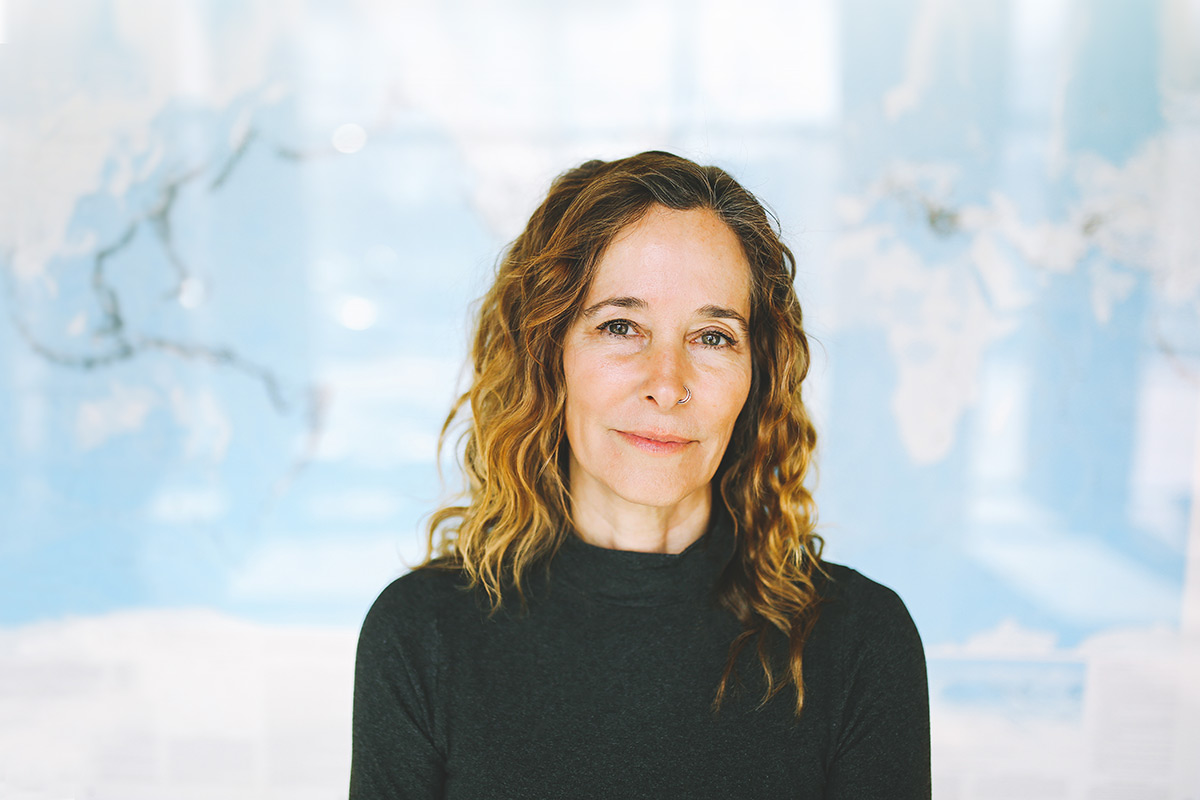Arctic scientist David Barber was asleep aboard the research icebreaker in the Beaufort Sea when he awoke confused as to why the vessel was moving so swiftly. It was early 2009 and the ship should have been grumbling through thick multi-year sea ice, he thought, not humming smoothly along.
He hurried to the bridge, looked out over the water, and saw that the ice was “rotten.” It was thin and weak. The UM professor, alum and Canada Research Chair, who died in 2022, brought his concerns to Parliament, declaring with some urgency: “I’ve never seen anything like this in my 30 years of working in the high Arctic.”
Snow, it turned out, was fooling satellite measurements so the models Barber [BPE/82, MNRM/88]—and everyone else in the scientific community—was using were wrong. Things were worse than expected.
Three years later Julienne Stroeve was aboard a research ship in the Barents Sea. Satellite data suggested that everywhere she’d look she’d see sea ice. But standing on the deck, she saw only half the water had ice cover. Clouds or fog were likely to blame this time for messing up the algorithms. Still, the satellite algorithms were, again, wrong and things were, again, worse than expected.
Stroeve (pronounced Stroo-va), a Senior Canada-150 Research Chair in Climate Forcing of Sea Ice at the University of Manitoba, was rattled but unsurprised—after all, she had published findings in a 2007 paper, “Arctic sea ice decline: Faster than forecast,” that reverberated among people who closely follow such matters, including former US Vice-President Al Gore, US congressional staff, the World Economic Forum and even the CIA, all of whom sought an audience with her to learn more.
What she said to them then is what she reiterated in her recent conversation with UM President and Vice-Chancellor Michael Benarroch, during his podcast What’s the Big Idea? She warned models are far too modest, changes will come at us faster than expected, and we’re not acting quick enough.
“The models are still too conservative,” she says. “And I am concerned. The sea ice in the Arctic will be the first big transformation that we’re going to see within our lifetimes. I think at this point, it’s unavoidable that we’ll see summers ice free. Whether it happens in 2035, whether it happens 2050, it’s going to happen. So that’s a huge climate shift and we don’t fully understand the ramifications of that.”
Stroeve runs through a list of troubles: no ice means storms will bash coasts, eroding soil and further melting permafrost; animals that depend on that ice will die or adapt in ways we don’t know; and without ice reflecting the sun’s energy away, the Arctic ocean will warm and release that heat to the atmosphere which can further melt the Greenland ice sheet, raising sea levels and altering ocean currents.
“There’s a whole host of things that are coming in the not too distant future. And you know, we can run the models and we can try to simulate what we think will happen when this transformation happens. But again, it is a model and we’ll see how the real world actually responds.”

Julienne Stroeve runs field experiments across the Arctic and also in the Antarctic. She grew up wanting to be an astronaut and now compares working in such a unique landscape to walking on the Moon // This photo and above by Rachael King
Stroeve is among the global recruits who were eager to join UM’s hub of experts at the Centre for Earth Observation Science—she calls the French Alps home and splits her teaching roles with UM and University of College, London. Manitoba occupies a unique geographic prominence in this field of study with Churchill being Canada’s most northerly port. For decades UM researchers of the Clayton H. Riddell Faculty of Environment, Earth, and Resources have been at the forefront of discovery in the Arctic in part because they’ve got their feet on the snow-packed ground.
And now with the UM’s newest base, the Churchill Marine Observatory (CMO), research will intensify around sea ice and a host of related, emerging issues and opportunities for local communities as the Arctic opens like never before, namely to new shipping routes. From the western shore of Hudson Bay, the CMO will focus on the scientific, technological and socio-environmental issues pertaining to the sustainable development of the North in this changing climate.
A truly ice-free Arctic is something we do not know much about, Stroeve says. And we don’t know when the Arctic was last in this state. Some have proposed it was 6-7,000 years ago based on finding ancient driftwood in Greenland that came from either Siberia or Alaska. But, she notes, pockets of open water regularly occur and the wood could have floated through such a channel when there was still much ice cover around.
Stroeve predicts the first ice free summer will likely happen somewhere between 2035 and 2060 and the uncertainty stems, in large part, from weather, which is unpredictable and impactful—a storm can suddenly push ice into warmer water where it melts, for instance.
The sea ice in the Arctic will be the first big transformation that we're going to see within our lifetimes.
Scientists like Stroeve diligently work to collect data and refine models. When the models match reality, however, it often required that scientists manipulate the algorithm to catch up with real life. So, “when they are right they are often right for the wrong reasons,” she says. What is becoming clear, though, is that ice cover keeps getting smaller and at rates much faster than expected.
“We’re not acting quick enough. That’s the thing. And I feel like we don’t have any real strong governmental leadership to take charge. I mean, even in Europe, which I feel is a bit more progressive about climate change, there are more people thinking this is a real issue and a real problem, yet you still don’t see big leadership taking the necessary steps to turn things around.”
One topic that is gaining interest is geoengineering—deliberately tinkering with Earth’s systems to offset the worst effects of greenhouse-gas-driven global warming. There are a few branches of it and in the last 10 years solar geoengineering has earned a lot of ink. Indeed, it has been the focus of reports by the European Commission and Parliament, the US government, the Climate Overshoot Commission, and the United Nations.
Solar geoengineering could involve spreading chemicals across the high atmosphere to mimic a volcanic eruption, but on a larger scale. These particles would reflect more of the sun’s energy back into space to reduce the Earth’s warming.
Such ideas worry Stroeve, who comes from an aerospace engineering background herself.
“That, to me, is terrifying. Those are things that are getting a lot more traction—funding agencies are fueling more studies to look at the impacts of this. So again it’s, you know, instead of fixing the problem, we’re just creating another thing to try to reduce the impact or reduce the sun’s energy coming to us so we can try to cool the planet down rather than actually get rid of the greenhouse gases—what we need to do.”
Given the intensified lens on the future of the Arctic, UM Today the Magazine asked President Michael Benarroch for his thoughts on the university’s research impact in the region.
UM Today: Why are we uniquely positioned to lead this type of work?
Benarroch: I’ll give you three reasons, all interconnected. The first is geography. Manitoba has North America’s only deep-water port in the Arctic Ocean. So that alone sets us apart, but then we have the second reason, and that is people. UM has two Canada Excellence Research Chairs, a Canada 150 Research Chair, a Tier 1 Canada Research Chair and three Tier 2 Canada Research Chairs all connected to Arctic research—and those are just the chairs. There are many other faculty, staff and students from diverse disciplines working in the Arctic.
And the third reason that makes this all click together is our partnerships. For a long time we have been building partnerships with Indigenous community leaders, businesses, NGOs, and all levels of government across the Arctic. This is key. It’s what makes us stand out above all others.
Why should we feel a responsibility to take this work on?
The most rapid effects of climate change are happening in the Arctic so our immediate thoughts turn to local communities and ecosystems and helping where we can. Climate change is bringing unprecedented challenges, but it also brings unprecedented opportunities and I’ll mention two. The first is that Manitoba can become a major shipping destination. And secondly, as the Arctic opens up, resource extraction will happen to some degree. So with these developments in mind, the questions before us are, first of all, how do we move forward with Indigenous and Arctic communities to ensure our work brings truly positive benefits to their communities, which in turn, would benefit the rest of Canada? And how do we responsibly proceed so that we can protect the environment?
This is the time to realize the true potential of Manitoba as a maritime transportation corridor, and we have the relationships and know-how to help us move forward responsibly.
What area is UM making the biggest impact in?
UM has one of—if not the—most influential Arctic sea ice groups in the world. From physics to remote sensing, to chemistry and biogeochemistry—you name it. And now, on top of this, we have the Churchill Marine Observatory, which is unlike anything else. We are already hosting ambassadors from Nordic countries who are interested in what we can do because this lab is of great importance to the world. It will allow us and our partners to run new experiments and that’s really exciting.
And this lab has come at a pivotal time in our history. It is thanks to the vision and bold thinking of our faculty and administrators many years ago who foresaw this need and our ability to once again lead in this field. CMO is a gamechanger and the world is depending on us to think big about how we use it, and we will.








A big priority for this endeavour will be to keep The Trump forces out of the Canadian Arctic. The uncontrolled greed for arctic resources now being exhibited will surely make CMO’s and other climatic research into global warming even more difficult.